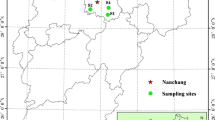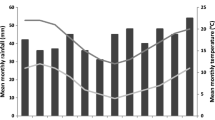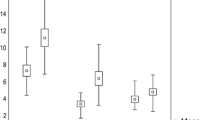Abstract
Water-stable aggregates isolated from three subtropical and one tropical soil (Western Georgia and China) were studied for their organic carbon, cation exchange capacity (CEC), specific surface area, magnetic susceptibility, and total chemical elements. The soils were also studied for their particle-size distribution, mineralogy, and nonsilicate Fe and Al oxides. Describe the water stability, three indices have been used: the content of water-stable macroaggregates (>0.25 mm), the mean weighted diameter of the aggregates, and the numerical aggregation index. The yellow-cinnamonic soil (China) was neutral, and the three other soils were acid. The soils were degraded with a low content of organic matter. The yellow-cinnamonic soil was characterized by the lowest water stability due to the predominantly vermiculite composition of the clay. The high water stability of the Oxisol structure was determined by the kaolinites and high content of oxides. In three out of the four soils studied, the hierarchical levels of the soil structure organization were defined; they were identified by the content of organic matter and the Ca + Mg (in Oxisols). Iron oxides mainly participated in the formation of micro-aggregates; Al and Mn contributed to the formation of macroaggregates. The water-stable aggregates acted as sorption geochemical barriers and accumulated Pb, Zn, Cd, Cs, and other trace elements up to concentrations exceeding their levels in the soil by 5 times and more. The highest correlations were obtained with CEC, Mn, and P rather than with organic carbon and Fe.
Similar content being viewed by others
References
T. V. Alekseeva, A. O. Alekseev, Z. Sokolowska, and M. Hajnos, “Relationship between Mineralogical Composition and Physical Properties of Soils,” Pochvovedenie, No. 5, 604–613 (1999) [Eur. Soil Sci. 32 (5), 548–557 (1999)].
T. V. Alekseeva, “Soil Microstructure and Factors of Its Formation,” Pochvovedenie, No. 6, 721–732 (2007) [Eur. Soil Sci. 40 (6), 649–659 (2007)].
I. N. Antipov-Karataev, V. V. Kellerman, and D. V. Khan, Soil Aggregate and Methods of Its Study (Akad. Nauk USSR, Moscow, 1948) [in Russian].
A. D. Voronin, Basic Soil Physics (Mosk. Gos. Univ., Moscow, 1986) [in Russian].
K. K. Gedroits, “Soil Structure and Its Agricultural Value,” Izv. Gos. Inst. Opytn. Agron. 4(3), 117–127 (1926).
M. A. Glazovskaya, “Criteria of Soil Classification According to the Hazard of Lead Contamination,” Pochvovedenie, No. 4, 110–120 (1994).
I. V. Ivanov, “Organization of Soil Systems,” in Soil Science: History, Sociology, and Methodology (Nauka, Moscow, 2005), pp. 236–243 [in Russian].
E. M. Korobova, N. P. Chizhikova, and V. G. Linnik, “Distribution of 137Cs in the Particle-Size Fractions and in the Profiles of Alluvial Soils on Floodplains of the Input and Its Tributary Buldynka Rivers (Bryansk oblast),” Pochvovedenie, No. 4, 404–417 (2007) [Eur. Soil Sci. 40 (4), 367–379 (2007)].
P. A. Kostychev, “Tillage and Fertilization of Chernozem,” in Collection of Kostychev’ Papers (St. Petersburg, 1892) [in Russian].
E. Yu. Milanovskii and E. V. Shein, “Functional Role of Amphiphilic Humus Components in Humus Structure Formation and Soil Genesis,” Pochvovedenie, No. 10, 1201–1213 (2002) [Eur. Soil Sci. 35 (10), 1064–1075 (2002)].
A. I. Perel’man, Geochemistry (Vysshaya Shkola, Moscow, 1989) [in Russian].
N. I. Savvinov, Soil Structure and Its Stability in Virgin, Fallow, and Old Arable Lands, Ed. by V. R. Williams (Sel’kolkhozgiz, Moscow, 1931) [in Russian].
Theories and Methods of Soil Physics, Ed. by E. V. Shein and L. O. Karpachevskii (Grif, Moscow, 2007) [in Russian].
A. F. Tyulin, “Problems of Soil Structure: II. Aggregate Analysis as an Auxiliary Method for Assessing the Real Soil Structure,” in Results of Works of the Agrochemical Department, Perm Experimental Station, on Flax (Perm, 1928) [in Russian].
D. V. Khan, Organo-Mineral Compounds and Soil Structure (Nauka, Moscow, 1969) [in Russian].
E. V. Shein, Course of Soil Physics (Mosk. Gos. Univ., Moscow, 2005) [in Russian].
A. A. Shinkarev and E. B. Perepelkina, “Humus Content and Composition in the Water-Stable Aggregates of Dark Gray Forest Soils,” Pochvovedenie, No. 2, 165–172 (1997) [Eur. Soil Sci. 30 (2), 135–141 (1997)].
T. Alekseeva and A. Alekseev, “Factors Influencing the Structural Stability of Three Contrasting Soils of China,” Catena 38, 45–64 (1999).
R. Brewer, Fabric and Mineral Analysis of Soils (Wiley, New York, 1964).
J. B. Dixon, “Kaolin and Serpentine Group Minerals,” in Minerals in Soil Environment, 2nd ed., Ed. by J. B. Dixon and S. B. Weed (Soil Sci. Soc. Am., Madison, 1989), pp. 467–525.
B. Dobrzanski, B. Witkowska, and R. Walczak, “Soil Aggregation and Water Stability Index,” Pol. J. Soil Sci. 8(1), 3–8 (1975).
A. P. Edwards and J. M. Bremner, “Microaggregates in Soils,” J. Soil Sci. 18, 64–73 (1967).
E. T. Elliott, “Aggregate Structure and Carbon, Nitrogen, and Phosphorous in Native and Cultivated Soils,” Soil Sci. Soc. Am. J. 50, 627–633 (1986).
C. Igwe and K. Stahr, “Water-Stable Aggregates of Flooded Inceptisols from Southeastern Nigeria in Relation to Mineralogy and Chemical Properties,” Aust. J. Soil Res. 42, 171–179 (2004).
G. S. R. Krishna-Murti, G. Singh, and P. Rengasamy, “The Nature of Soil Clays and the Stability of Microaggregates,” Aust. J. Soil Res. 15, 115–119 (1977).
Z.-X. Li, C.-F. Cai, Z.-H. Shi, and T.-W. Wang, “Aggregate Stability and Its Relationship with Some Chemical Properties of Red Soils in Subtropical China,” Pedosphere 15(1), 129–136 (2005).
Y. A. Martel, C. R. De Kimpe, and M. R. Laverdiere, “Cation-Exchange Capacity of Clay Rich Soils in Relation to Organic Matter, Mineral Composition, and Surface Area,” Soil Sci. Soc. Am. J. 42(5), 764–767 (1978).
J. S. C. Mbagwu and U. Schwertmann, “Some Factors Affecting Clay Dispersion and Aggregate Stability in Selected Soils of Nigeria,” Int. Agrophysics 20, 23–30 (2006).
C. C. Muggler, P. Buurman, and Th. Pape, “Laser Grain-Size Determination in Soil Genetic Studies: 2. Clay Content, Clay Formation, and Aggregation in Some Brazilian Oxisols,” Soil Sci., 219–228 (1997).
J. M. Oades and A. G. Waters, “Aggregate Hierarchy in Soils,” Aust. J. Soil Res. 29, 815–828 (1991).
E. Paterson and J. Stawinski, “The Use of a Vacuum Microbalance in the Investigation of the Kinetics of Water Vapor Adsorption on Soil Components,” Pol. J. Soil Sci. 12, 105–111 (1979).
X. Peng, B. Zhang, Q. Zhao, R. Horn, and P. D. Hallett, “Influence of Types of Restorative Vegetation on the Wetting Properties of Aggregates in a Severely Degraded Clayey Ultisol in Subtropical China,” Geoderma 115, 313–324 (2003).
D. Pinheiro-Dick and U. Schwertmann, “Microaggregates from Oxisols and Inceptisols: Dispersion through Selective Dissolution and Physicochemical Treatments,” Geoderma 74, 49–63 (1996).
J. Six, E. T. Elliott, K. Paustian, and J. W. Doran, “Aggregation and Soil Organic Matter Accumulation in Cultivated and Native Grassland Soils,” Soil Sci. Soc. Am. J. 62, 1367–1377 (1998).
J. Six, H. Bossuyt, S. Degryze, and K. Denef, “A History of Research on the Link Between (Micro)Aggregates, Soil Biota and Soil Organic Matter Dynamics,” Soil Tillage Res. 79, 7–31 (2004).
J. M. Tisdall and J. M. Oades, “Organic Matter and Water-Stable Aggregates in Soils,” J. Soil Sci. 33, 141–163 (1982).
J. Torrent, “Iron Oxides in Mediterranean Soils: Properties and Influences on Soil Behavior,” in The 15th World Congress of Soil Science, Acapulco, Mexico, 1994 (Acapulco, 1994), Vol. 8a, pp. 2–14.
R. K. Xu and G. L. Ji, “The Chemical Species of Aluminum Ions in Acid Soils,” Pedosphere 8(2), 127–133 (1998).
T. Yamaguchi, T. Takei, M. T. F. Wong, R. J. Gilkes, and R. S. Swift, “Effect of Humic Acid, Sodium, and Calcium Additions on the Formation of Water-Stable Aggregates in Western Australian Wheatbelt Soils,” Aust. J. Soil Res. 42, 435–439 (2004).
Q.-G. Zhao, Z.-T. Gong, C.-Q. Hou, and G.-C. Zou, Ferralitic Soils, Soil Research Report, No. 32 (Inst. of Soil Sci., Acad. Sinica, 1986).
Author information
Authors and Affiliations
Additional information
Original Russian Text © T.V. Alekseeva, Z. Sokolowska, M. Hajnos, A.O. Alekseev, P.I. Kalinin, 2009, published in Pochvovedenie, 2009, No. 4, pp. 452–462.
Rights and permissions
About this article
Cite this article
Alekseeva, T.V., Sokolowska, Z., Hajnos, M. et al. Water stability of aggregates in subtropical and tropical soils (Georgia and China) and its relationships with the mineralogy and chemical properties. Eurasian Soil Sc. 42, 415–425 (2009). https://doi.org/10.1134/S1064229309040085
Received:
Accepted:
Published:
Issue Date:
DOI: https://doi.org/10.1134/S1064229309040085




